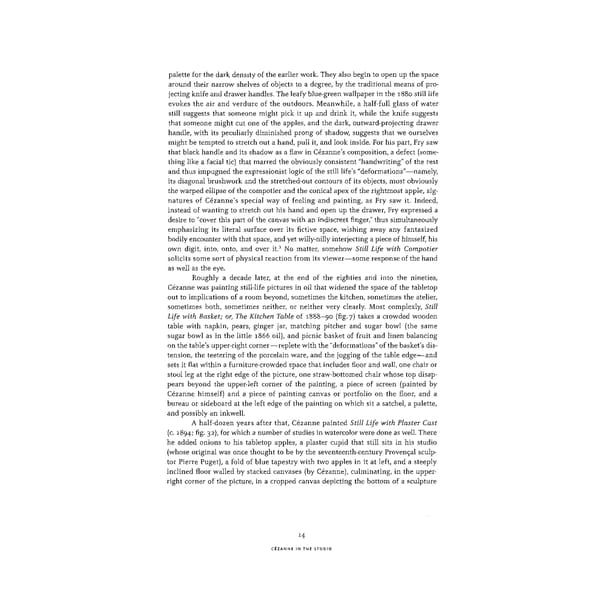palette for the dark density of the earlier work. They also begin to open up the space around their narrow shelves of objects to a degree, by the traditional means of pro- jecting knife and drawer handles. The leafy blue-green wallpaper in the 1880 still life evokes the air and verdure of the outdoors. Meanwhile, a half-full glass of water still suggests that someone might pick it up and drink it, while the knife suggests that someone might cut one of the apples, and the dark, outward-projecting drawer handle, with its peculiarly diminished prong of shadow, suggests that we ourselves might be tempted to stretch out a hand, pull it, and look inside. For his part, Fry saw that black handle and its shadow as a flaw in Cezanne's composition, a defect (some- thing like a facial tic) that marred the obviously consistent "handwriting" of the rest and thus impugned the expressionist logic of the still life's "deformations"—namely, its diagonal brushwork and the stretched-out contours of its objects, most obviously the warped ellipse of the compotier and the conical apex of the rightmost apple, sig- natures of Cezanne's special way of feeling and painting, as Fry saw it. Indeed, instead of wanting to stretch out his hand and open up the drawer, Fry expressed a desire to "cover this part of the canvas with an indiscreet finger," thus simultaneously emphasizing its literal surface over its fictive space, wishing away any fantasized bodily encounter with that space, and yet willy-nilly interjecting a piece of himself, his 3 own digit, into, onto, and over it. No matter, somehow Still Life with Compotier solicits some sort of physical reaction from its viewer—some response of the hand as well as the eye. Roughly a decade later, at the end of the eighties and into the nineties, Cezanne was painting still-life pictures in oil that widened the space of the tabletop out to implications of a room beyond, sometimes the kitchen, sometimes the atelier, sometimes both, sometimes neither, or neither very clearly. Most complexly, Still Life with Basket; or, The Kitchen Table of 1888-90 (fig. 7) takes a crowded wooden table with napkin, pears, ginger jar, matching pitcher and sugar bowl (the same sugar bowl as in the little 1866 oil), and picnic basket of fruit and linen balancing on the table's upper-right corner—replete with the "deformations" of the basket's dis- tension, the teetering of the porcelain ware, and the jogging of the table edge—and sets it flat within a furniture-crowded space that includes floor and wall, one chair or stool leg at the right edge of the picture, one straw-bottomed chair whose top disap- pears beyond the upper-left corner of the painting, a piece of screen (painted by Cezanne himself) and a piece of painting canvas or portfolio on the floor, and a bureau or sideboard at the left edge of the painting on which sit a satchel, a palette, and possibly an inkwell. A half-dozen years after that, Cezanne painted Still Life with Plaster Cast (c. 1894; fig. 32), for which a number of studies in watercolor were done as well. There he added onions to his tabletop apples, a plaster cupid that still sits in his studio (whose original was once thought to be by the seventeenth-century Provencal sculp- tor Pierre Puget), a fold of blue tapestry with two apples in it at left, and a steeply inclined floor walled by stacked canvases (by Cezanne), culminating, in the upper- right corner of the picture, in a cropped canvas depicting the bottom of a sculpture 14 CEZANNE IN THE STUDIO
 Cézanne in the Studio: Still Life in Watercolors Page 28 Page 30
Cézanne in the Studio: Still Life in Watercolors Page 28 Page 30